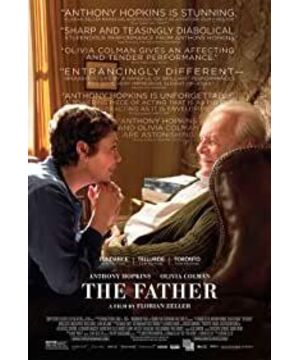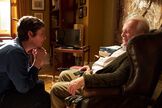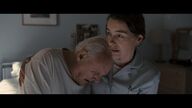The story art of memory, time and space intertwined
"The Father" (hereinafter referred to as "Father") after the first viewing of the movie, its subtle fragmented narrative method will deeply substitute the audience into the distorted memory of Alzheimer's disease (Alzheimer's disease). .
The last time I was dizzy and turned into a feeling of "memory disorder" was Nolan's "Memories" and Scorsese's "Bounded Island".
The former leads the audience to the world of short-term amnesia patients, a little bit from the result to the beginning, and the beginning of the story is the end of the film;
In the latter, a psychiatrist created a plausible drama in order to heal the trauma of Xiao Lizi's birth, which made the audience confused between reality and illusion.
The narrative and audio-visual methods used in "Father" are more like the combination of reality and reality in "Life and Death". Its sound and picture design has a very clear design purpose- to substitute the audience into the world of "Alzheimer's disease" patients.
After watching the film, is it a bit vague? Are there all kinds of questions going around in your mind?
1. What story does it tell?
2. Why is there chaos around Anthony?
3. Why is there an episode where Annie kills her father?
4. Who slapped Anthony?
5. Why does it feel messy?
...
The reason for the above problems is that we are subtly substituted into "Alzheimer's disease" by the director and screenwriter.
Its main features are:
1: Memory loss. It is easy to forget things or remember things wrong.
2: Cognitive distortion. That is, you can't distinguish the things in front of you, including time, place, people, etc.
3: Difficult to realize. That is, I am sick but I am not aware that I have a problem.
Before answering these questions, we take the following design premises to make it easier to understand the entire interesting story:
01
Design premise
Premise 1. Audience perspective:
① Anthony's mind -distorted and confused, true and false coexist
②Anne's perspective -objective reality from Annie's perspective
③The audience's perspective -the objective reality from the perspective of the third-person audience
Most of the time, we read the story in Anthony's mind. The picture features in the mind of "Alzheimer's disease" are fragmented, disordered in time sequence, and incorrectly assembled due to incorrect memory.
The same kitchen, different details
The same study, different details
One thing to pay special attention to here is that there is a feature of the images produced in the mind: you need to have seen, heard or experienced in reality to generate the corresponding images through memories, associations, etc. So although it is distorted, it must be partly real.
To make an analogy:
I ate sugar cane yesterday and played baseball with a baseball bat.
I remembered today as "I played baseball with sugar cane yesterday."
This premise is used to explain why Paul has Bill’s face and why the room layout changes in the film.
Premise 2. Time/space/event-similar superposition:
① Anthony's current reality
② Anthony's current mind
③The reality of Anthony
④ Anthony's previous mind
The whole movie has a very clever narrative method-similar superposition, for example:
The current reality: sitting in front of me is Fan Bingbing, I told her she is my wife, Fan Bingbing slapped me
The current mind: I thought Fan Bingbing sitting in front of me was Li Bingbing. I told her that she was my wife, and Li Bingbing slapped me.
The previous reality: Sitting in front of me was Li Bingbing, I told her she was my wife, Li Bingbing slapped me
Once in my mind: I thought Li Bingbing sitting in front of me was my wife Di Li Hot Hot, Di Li Hot Hot is indeed my wife
The logical relationship here is: Fan Bingbing I saw = Li Bingbing in my mind = Dili hot in my mind once = my wife, so I now think "Fan Bingbing = my wife"
Take the example in "Father", Anthony's logic is "the nursing home that he saw = the mansion in his mind = his own apartment in his mind = his own apartment", so he would also say "this is in my apartment" in the nursing home ( Here in my flat)" this sentence
The ingenuity of this design is that experiences similar events lead to the same wrong results, making people foolishly confused whether it happened "now" or "in the past ." This logic is extremely rigorous in the film, and the design is applied to many story details.
The application of this design in this video is not just as simple as what I said in the above example. Let’s talk about it later, and my brain will explode...
(No wonder you can turn the audience around, you can only say that the director and screenwriter are really bad and bad people...)
Premise 3. Key memory fragments:
The whole story revolves around the various memory fragments in Anthony's consciousness. I will classify it like this for the time being:
①The women Anthony likes: eldest daughter Anne, younger daughter Lucy, nurse Laura, nurse Catherine
②Women that Anthony doesn't like: all the nurses Anthony drove away, represented by the nurse Angela
③The man Anthony likes: himself (...)
④Men whom Anthony doesn’t like: Anne’s ex-husband James, Anne’s current Paul, male nurse Paul
⑤ Anthony's residence: own apartment, mansion, nursing home
⑥ Anthony's items: watches, gramophones, pajamas
Take the watch as an example. On the surface, Anthony has been looking for a watch from start to finish, showing that Anthony was unable to find a watch even when he lost his memory.
He accused the nursing staff of stealing his watch, but actually hid it by himself but forgot where to put it
When I met Laura for the first time, I found the watch was not in my hand.
The watch on Paul's hand is greedy
I can't find my watch when I get up in the nursing home
What does a watch symbolize?
Yes time
Close to crazy jump combinations between time, space, and characters, forming an exquisite disorderly design
Disorderly design ≠ chaotic design . Through clear room planning and detailed layout, the director makes space and time ingeniously complement each other, chaotic and orderly.
Premise 4. Everything is an illusion! -Anthony's combination of fragments:
This is very, very important. We pay attention to the conversation between the female nurse Catherine and Anthony at 1 hour 25 minutes in the video:
Your daughter is not here, Anthony, she lives in Paris. She has been there for several months. She lives in Paris because she met a man named Paul. She sometimes comes to see you, sometimes to spend the weekend, she comes here to take you for a walk in the park, she will tell you her new life, what she is doing
1. Annie did go to Paris because she fell in love, and her love partner was named Paul
2. After Anthony entered the nursing home, he did not meet Paul, because Paul and Anne lived in Paris;
①It is impossible for Anthony to have been to Paris;
②If Paul accompanied Anne to come back to see Anthony, Catherine would say here, "They come to see you sometimes..." instead of just "She sees you sometimes..."
3. In the story, the reason why Anthony has always been considered "Paul" is that Anthony remembered the name of "Paul" in Anne's recounting to him when she came back to visit him.
Based on the above objective information, all the interactions between Anthony and "Paul" in the story are actually fragments experienced when he was with Anne’s ex-husband James (I think this explosive information is the most ingenious point of the director and screenwriter for hiding hidden information)
The reason why Anne and James divorced, Anthony was the most important reason that caused Anne and James to be unable to enjoy a normal married life.
The whole story with Anthony as the main perspective in the second act is a splicing combination of all the fragments in Anthony’s brain, combining reality and fiction.
The above is the premise of watching movies.
Disorderly design ≠ chaotic design . Through clear room planning and detailed layout, the director makes space and time ingeniously complement each other, chaotic and orderly
The story in Anthony’s mind, under the subtle weaving of the director
Presented to the audience a touching story of ingenious workmanship
02
Story summary
What story does "Father" tell? Anthony, an old man suffering from "Alzheimer", firmly believes that there is nothing wrong with his memory.
Under the care of his daughter, he opposes both nursing care and moving to a nursing home.
After witnessing a series of chaotic times and unpredictable relatives,
Anthony reluctantly realized that he was already in the nursing home, and the past in his mind was only a mess of splicing.
The despair of his later years ran freely under Anthony's tears.
According to the information in the film, sort out the key events that Anthony has experienced in an objective chronological order:
- Anthony lives in his apartment.
- Daughter Anne lives with her ex-husband James for about 10 years.
- The youngest daughter Lucy died in an accident.
- Anthony was in a serious condition, and Annie sought multiple care for him, but they were all driven away by Anthony.
- After Anthony drove Angela to take care of Angela, Anne took him to the apartment where she and James lived together.
- Anthony caused a lot of inconvenience to the couple. He recognized this apartment as his home in James Apartment, and often treated Anne and James as strangers, which indirectly caused the cancellation of the Anne and his wife's plan to go to Italy, which caused James to be extremely dissatisfied with him.
- Annie finds Laura, a new caregiver for Anthony, at James's house.
- Anne and James quarreled over Anthony's illness and whereabouts. Annie divorced James.
- Annie took her father back to Anthony's residence. Take care of Laura and take care of Anthony. But Anthony's condition worsened day by day, and even Laura didn't know him and drove Laura away.
- At least 5 years after Anne and James divorced, Anne found her new male partner Paul in Paris. In addition, her father's condition was so serious that she could not take care of her, so she sent Anthony to a nursing home.
- Anthony was taken care of by female nurse Catherine and male nurse Bill in the nursing home.
- While Anthony was in the nursing home, his daughter Anne would occasionally write letters or come back to accompany her father, telling him about her life with Paul in Paris.
- Anthony became more and more ill during the nursing home. He often forgot or confuses many things, and said a lot of confusing words that are incomprehensible. And these confusions are logically woven in Anthony's mind... Don't believe it? Let's look at Anthony's mind...
OK, with the above premise, in the next article, I will dig out the secrets in the story of the film in detail
View more about The Father reviews











